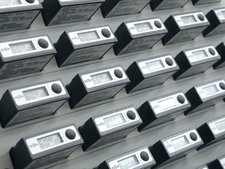Operational radiation protection
Operational radiation protection includes both the dosimetric monitoring of staff and visitors and the monitoring of the facilities themselves. The Federal Office for Radiation Protection (BfS) has taken a number of measures in order to prevent people from being exposed to any radiation hazards. Defined radiation protection areas, dosimetric monitoring and contamination controls are used to protect staff and visitors from unacceptable radiation exposure.
The metrological monitoring system is intended to guarantee that the limit values set out in the long-term operating permit for the Morsleben Repository and in the Radiation Protection Ordinance are not exceeded (these limit values ensuring the protection of staff and visitors). It is also used to keep the total radiation exposure (also in the range below the limit values) as low as possible considering all the aspects of individual situations. To this end, comprehensive radiation protection measures are performed at the Morsleben Repository:
- individual dosimetric monitoring (external and internal exposure) and
- in-plant radiation protection controls.
Additional tasks to be performed in the context of operational radiation protection result from the long-term operating permit and the system of rules governing the operation of the Morsleben Repository.
Individual dosimetric monitoring – external exposure
Insofar as individuals might suffer an increased radiation exposure – at the Morsleben Repository, this is the case for people entering the control area (radiation protection area) – radiation protection monitoring is performed via personal dose measurement. A dosimeter is used to determine the level of the individual radiation exposure.
People working within the control area are monitored with the help of both operational dosimeters and official dosimeters. The competent official body for measuring the personal dose is the Landesanstalt für Personendosimetrie und Strahlenschutzausbildung (Regional Office for Personal Dosimetry and Radiation Protection Training; LPS) in Berlin. The assessments performed by LPS show that the exposure of professionally exposed individuals working at the Morsleben Repository is far below the limit values.
Individual dosimetric monitoring – internal exposure
Air-borne radioactive substances (radionuclides) may enter the human body via mouth, nose and open wounds and can even penetrate through intact skin. This process called incorporation leads to a certain level of internal exposure.
Professionally exposed staff who might incidentally incorporate radionuclides at work must be regularly examined. With respect to the Morsleben Repository, representative control groups are annually checked with the help of BfS' whole body counter in Berlin. Urine samples are analysed in order to determine a potential incorporation of tritium. The examination results have not yet provided any evidence of an increased operational radiation exposure due to the incorporation of radionuclides.
In-plant radiation protection controls
In order to discover a potential contamination people's hands, feet and clothes are surveyed. Various measurement devices are used to this end, such as monitors for hands, feet and clothes or the whole body counter system contained in a cubicle. Direct measurements via portable contamination monitors and so-called wipe tests are performed in order to verify if the operational facilities are contaminated. For the wipe test, small paper filters are wiped over the surfaces of in-plant installations. The sample is then inserted into a radiation measurement device and checked for a potential radioactive contamination.
The results from these examinations also show that the values are always far below the legal limit.
The mine air is monitored through a combination of different devices matched to the individual measuring tasks (determining the concentration of different radionuclides). These devices are stored in measurement containers. Three measurement containers exist at the Morsleben Repository, each container monitoring certain deposit areas. Additionally, mobile sampling devices are used in order to monitor the radioactivity bound to air-borne particles. The radon activity concentration is measured via mobile and passive measuring devices.
The measuring results do not show any evidence of an unacceptable mine air contamination. Short-term peak values detected in the context of closing the residual cavity in the Southern field were of no radiological relevance.
State of 2017.01.03


